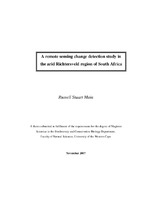| dc.contributor.advisor | Knight, Richard | |
| dc.contributor.author | Main, Russell Stuart | |
| dc.contributor.other | Faculty of Science | |
| dc.date.accessioned | 2013-11-21T15:35:18Z | |
| dc.date.available | 2009/11/04 10:17 | |
| dc.date.available | 2009/11/04 | |
| dc.date.available | 2013-11-21T15:35:18Z | |
| dc.date.issued | 2007 | |
| dc.identifier.uri | http://hdl.handle.net/11394/2411 | |
| dc.description | Magister Scientiae - MSc (Biodiversity and Conservation Biology) | en_US |
| dc.description.abstract | The Richtersveld falls within the succulent karoo and dester biomes. This studu made use of remote sensing technologies in order to investigate possible vegetation cover changes that have taken place over time, and which have manifested through a combination of threats to the region. Te aims of the study were adressed using three key questions that sought to gainan understanding of the relationship between vegetation response and moisture, in order to interpret teporal and spatial vegetyation cover changes. A spartially and temporarily representative remotely sensed dataset was used together with techniques that are repeatable and able to quantify change with a limited human bias. | en_US |
| dc.language.iso | en | en_US |
| dc.publisher | University of the Western Cape | en_US |
| dc.subject | Remote sensing | en_US |
| dc.title | A Remote sensing change detection study in the arid Richtersveld region of South Africa | en_US |
| dc.type | Thesis | en_US |
| dc.rights.holder | University of the Western Cape | en_US |
| dc.description.country | South Africa | |

